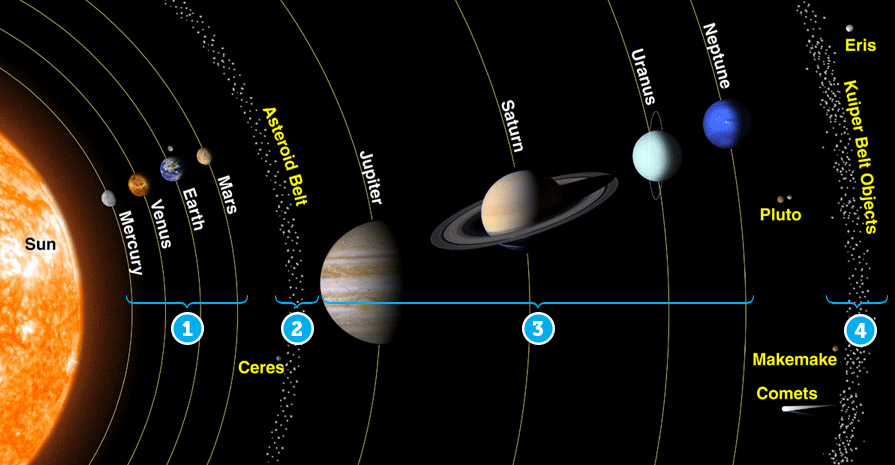
The Solar System: Our Celestial Neighborhood
The solar system, an awe-inspiring expanse of celestial bodies, has fascinated humans for millennia. This remarkable cosmic system, dominated by the Sun and containing a diverse array of planets, moons, asteroids, and comets, is not just a scientific wonder but also a source of endless curiosity and exploration. In this comprehensive article, we will embark on a journey through our solar system, uncovering its origin, its myriad components, and the profound impact it has on our understanding of the universe.
A Cosmic Neighborhood: Introduction to the Solar System
The Sun: At the heart of our solar system lies the Sun, a blazing ball of hot, glowing gas primarily composed of hydrogen and helium. It provides the gravitational anchor that binds the solar system together and is the source of virtually all the energy that sustains life on Earth.
Planets: Orbiting the Sun are eight planets, each with its distinct characteristics. These planets can be categorized into two main groups:
Inner Planets (Terrestrial Planets)
- Mercury: The closest planet to the Sun, Mercury is a barren, rocky world with extreme temperature variations.
- Venus: Venus, often referred to as Earth’s “sister planet,” shares a similar size and composition but has a thick, toxic atmosphere and extreme surface temperatures.
- Earth: Our home, Earth is the only known planet to support life, featuring a diverse range of ecosystems and environments.
- Mars: Often dubbed the “Red Planet” due to its reddish appearance, Mars has captured human imagination for its potential as a future destination for exploration and colonization.
Outer Planets (Gas Giants)
- Jupiter: The largest planet in the solar system, Jupiter is a gas giant with a powerful magnetic field and a host of moons, including the Galilean moons.
- Saturn: Known for its spectacular ring system, Saturn is another gas giant with a diverse collection of moons.
- Uranus: Uranus is an ice giant, distinguished by its peculiar tilted axis of rotation.
- Neptune: The farthest planet from the Sun, Neptune is an ice giant with strong winds and a dark, stormy atmosphere.
Dwarf Planets: In addition to the eight planets, our solar system is home to a category of celestial objects known as dwarf planets. Pluto, Eris, Haumea, Makemake, and Ceres are among the recognized dwarf planets in our cosmic neighborhood.
Moons: The Celestial Entourage
The planets in our solar system are often accompanied by a retinue of natural satellites, or moons. These moons exhibit a remarkable diversity of features and geological characteristics. For instance, Jupiter’s moon Io is known for its volcanic activity, while Saturn’s Enceladus hides a subsurface ocean beneath its icy exterior. Earth’s moon, the only one known to support human life, has been a subject of exploration and scientific study for centuries.
Asteroids and Comets: Cosmic Wanderers
Asteroids: These rocky remnants from the early solar system orbit the Sun, primarily located in the asteroid belt between Mars and Jupiter. Some, like the dwarf planet Ceres, are large enough to be classified as both asteroids and dwarf planets.
Comets: Comets are icy bodies originating from the distant reaches of the solar system. As they approach the Sun, they develop bright, glowing tails due to the sublimation of their ices. Famous comets like Halley’s Comet and Comet NEOWISE have graced our skies, leaving a lasting impression on observers.
The Formation and Evolution of the Solar System
The solar system’s origin is believed to trace back to a massive cloud of gas and dust known as the solar nebula. Roughly 4.6 billion years ago, this nebula underwent gravitational collapse, leading to the formation of the Sun at its center. As the Sun ignited, it cleared its surroundings of debris and initiated the birth of planets, moons, and other celestial objects from the remaining material.
Exploration and Future Endeavors
Human exploration of the solar system has greatly expanded our knowledge and understanding of its components. The advent of space probes and telescopes has enabled us to study distant planets and celestial bodies up close. Missions like the Voyager probes, Mars rovers, and the New Horizons mission to Pluto have provided unprecedented insights.
Looking to the future, space agencies worldwide, including NASA and ESA, continue to plan ambitious missions to explore and understand the solar system further. These missions include sending astronauts back to the Moon, exploring the subsurface oceans of icy moons like Europa, and launching missions to study asteroids and comets.
Conclusion
The solar system is not merely a collection of celestial bodies; it’s a gateway to understanding the universe’s profound mysteries and our place within it. From the relentless heat of Mercury to the icy winds of Neptune, from the serene beauty of Saturn’s rings to the chaotic geology of Jupiter’s moon Io, our solar system offers an incredible diversity that captivates scientists, astronomers, and space enthusiasts alike. As we continue to explore and unravel the secrets of our cosmic neighborhood, we gain valuable insights into the formation and evolution of celestial bodies and their potential for future human exploration.
